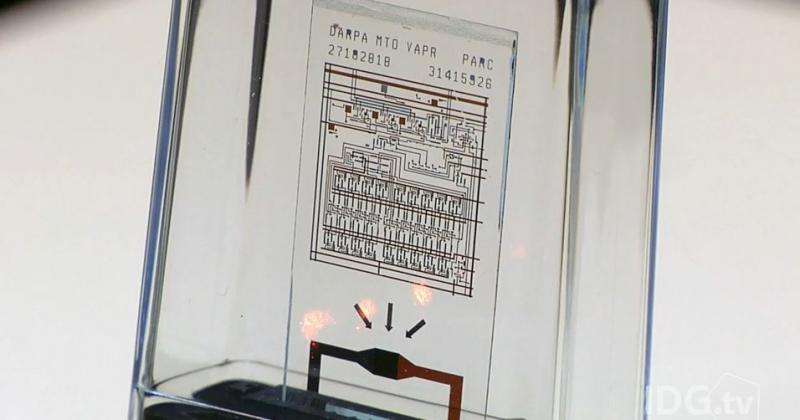September 14, 2015 weblog
Xerox PARC chip shatters on command, shards all that remain

Engineers at PARC, a Xerox company, have come up with a chip that will self-destruct on command; it was demonstrated at DARPA's Wait, What? event in St. Louis on Thursday.
The chip was developed under the Defense Advanced Research Projects Agency (DARPA), part of the latter's Vanishing Programmable Resources (VAPR) program.
Last year, PARC spoke of DARPA's goal, to demonstrate electronic systems capable of physically disappearing in a controlled, triggerable manner. In April 2014, PARC issued a news release, "PARC Awarded Up To $2 Million from DARPA to Develop Vanishing Electronics" in which it revealed its contract with the Defense Advanced Research Projects Agency to develop a "disappearing electronics" platform called DUST, which stands for Disintegration Upon Stress-Release Trigger.
"Sophisticated electronics can be made at low cost and are increasingly pervasive throughout the battlefield," the announcement said. "Large numbers can be widely proliferated and used for applications such as distributed remote sensing and communications. However, it is nearly impossible to track and recover every device, resulting in unintended accumulation in the environment, potential unauthorized use, and compromise of intellectual property and technological advantage."
The chip, demonstrated at the Thursday event, could be used to store data such as encryption keys but, on command could shatter into pieces so small that it would be it impossible to reconstruct.
Military applications come to mind; also, commercial and scientific could find use for the DUST technology.
The 2014 announcement noted how in environment science DUST sensors could find use to measure weather patterns such as hurricane predictions or vibrations preceding earthquakes but then be removed from the environment with no footprint. PARC's Sean Garner, part of the DUST project, "Imagine," said Garner, "being able to cover a large area, like the ocean floor, with billions of tiny sensors to 'hear' what is happening within the earth's crust, and have them quickly disintegrate into, essentially, sand, leaving no trace and not harming the planet or sea life."
Martyn Williams, senior U.S. correspondent, IDG News Service, reported on the Thursday event; he quoted Gregory Whiting, a PARC senior scientist:
"We really wanted to come up with a system that was very rapid and compatible with commercial electronics."
A chip is fabricated on a glass substrate. "We take the glass and we ion-exchange temper it to build in stress," said Whiting in the IDG News report.
The glass was stressed to breaking point by heat. Reported Williams: "When a circuit was switched on, a small resistor heated up and the glass shattered into thousands of pieces. Even after it broke up, stress remained in the fragments and they continued breaking into even smaller pieces for tens of seconds afterwards." (The self-destruct circuit was triggered by a photo-diode, which switched on the circuit when a bright light fell on it. In the demo, the light was provided by a laser, but the trigger could be anything from a mechanical switch to a radio signal, said Williams.)
Beyond a future in security and environmental sciences, Popular Mechanics' John Wenz offered his suggestion for its future. He said it could make for "a great hackathon for people to figure out how to break into a system and shatter the chips (supposing a triggering element is installed internally) in order to either further strengthen the security, or just to be a butthead."
© 2015 Tech Xplore




















